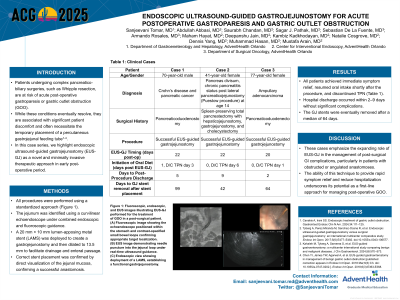Monday Poster Session
Category: Endoscopy Video Forum
P2725 - Endoscopic Ultrasound-Guided Gastrojejunostomy (EUS-GJ) for Acute Postoperative Gastroparesis and Gastric Outlet Obstruction


Sanjeevani Tomar, MD
AdventHealth Orlando
Orlando, FL
Presenting Author(s)
Sanjeevani Tomar, MD1, Saurabh Chandan, MD2, Abdullah Abbasi, MD2, Sagar J.. Pathak, MD2, Sebastian G.. De La Fuente, MD1, Armando Rosales, MD3, Maham Hayat, MD2, Deepanshu Jain, MD2, Kambiz Kadkhodayan, MD2, Natalie Cosgrove, MD2, Dennis Yang, MD, FACG4, Muhammad Hasan, MD, FACG2, Mustafa Arain, MD2
1AdventHealth Orlando, Orlando, FL; 2Center for Interventional Endoscopy, AdventHealth Orlando, Orlando, FL; 3AdventHealth, Orlando, FL; 4Center for Interventional Endoscopic, AdventHealth Orlando, Orlando, FL
Introduction:
Patients undergoing complex pancreatico-biliary surgeries, such as Whipple resection, are at risk of acute post-operative gastroparesis or gastric outlet obstruction. While these conditions eventually resolve, they are associated with significant patient discomfort and often necessitate the temporary placement of a percutaneous gastrojejunal (PEG-J) feeding tube. In this video, we highlight EUS-GJ as a novel and minimally invasive therapeutic approach in early post-operative period.
Case Description/Methods:
The first case involved a 70-year-old male who underwent pancreaticoduodenostomy for pancreatic cancer and developed GOO due to anastomotic edema, requiring nasogastric decompression and TPN. On post-operative day (POD) 22, EUS-GJ was performed. The patient resumed oral intake by post-procedure day 1, TPN was discontinued by day 3, and he was discharged soon after.
The second case was a 41-year-old female post-total pancreatectomy with gastrojejunostomy for chronic pancreatitis who developed functional obstruction and significant GI bleeding. EGD revealed ulcerated mucosa at the GJ anastomosis, managed with thermal therapy and hemostatic gel. EUS-GJ was performed on POD 22, with same-day tolerance of oral intake. TPN was weaned by day 6, and she was discharged 9 days later.
The third case involved a 77-year-old female who developed GOO after pancreaticoduodenectomy for ampullary adenocarcinoma. EUS-GJ on POD 20 resulted in immediate symptom relief and same-day resumption of oral intake. TPN was stopped on day 1, and she was discharged within 2 days.
All procedures followed a standardized approach: using a curvilinear echoendoscope, the jejunum was identified under endoscopic and fluoroscopic guidance. A 20 mm × 10 mm lumen-apposing metal stent (LAMS) was deployed to create a gastrojejunostomy, then dilated to 13.5 mm to facilitate drainage and enteral passage.
All patients achieved immediate symptom relief, resumed oral intake shortly after post-procedure, and discontinued TPN. Hospital discharge occurred within 2–9 days without significant complications. The GJ stents were eventually removed after a median of 64 days.
Discussion: These cases emphasize the expanding role of EUS-GJ in the management of post-surgical GI complications, particularly in patients with obstructed or angulated anastomoses. The ability of this technique to provide rapid symptom relief and reduce hospitalization underscores its potential as a first-line approach for managing post-operative GOO.
Disclosures:
Sanjeevani Tomar, MD1, Saurabh Chandan, MD2, Abdullah Abbasi, MD2, Sagar J.. Pathak, MD2, Sebastian G.. De La Fuente, MD1, Armando Rosales, MD3, Maham Hayat, MD2, Deepanshu Jain, MD2, Kambiz Kadkhodayan, MD2, Natalie Cosgrove, MD2, Dennis Yang, MD, FACG4, Muhammad Hasan, MD, FACG2, Mustafa Arain, MD2. P2725 - Endoscopic Ultrasound-Guided Gastrojejunostomy (EUS-GJ) for Acute Postoperative Gastroparesis and Gastric Outlet Obstruction, ACG 2025 Annual Scientific Meeting Abstracts. Phoenix, AZ: American College of Gastroenterology.

